| 1 |
 |
This is a perforating machine. It was owned by the late Tony Scott of Film and Photo. It was apparently made during World War II. | |
| 2 |
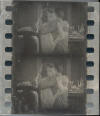 |
An image printed unto metallic film. | This is an article from 'Home
Movies and Home Talkies June 1939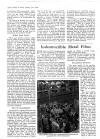 The system was patented in 1925 by Robert W Carter here is his patent CA249966A
A French PhD thesis by Philippe Rouyer www.uk-us.fr/agedor.pdf covered the process. Here is a translation of the section kindly provided by Mikael Barnard and Boris Curwen
|
| 3 |
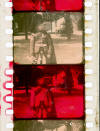
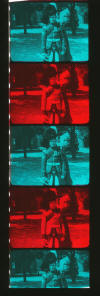 |
This is a piece of two colour additive film. The film is sepia toned and alternate frames coloured red. It is possibly an early test by G Albert Smith, inventor of Kinemacolor. I have recently come across the picture on the right which is Biocolor so the left hand picture is probably a test by Freise-Green and not Smith |
 This
is a digital composition from the left hand frames made with Photoshop 7 and
also from the right hand frames. This
is a digital composition from the left hand frames made with Photoshop 7 and
also from the right hand frames. |
| 4 |
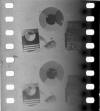 |
An early two colour experimental negative, possibly George Albert Smith. It should be possible to identify the date from the copy of the 'Bioscope' photographed. |
This
is a digital composition from the above frames made with Photoshop 7. the above frames made with Photoshop 7. |
| 5 |
 |
The device made by Vinten for Claude Friese-Green to colour alternate frames red and green. It enabled 6 frames to be coloured simultaneously. | |
| 6 |
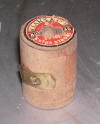 |
A film core made from a wooden cotton reel. | |
| 7 |
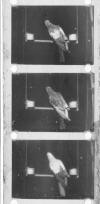 |
Lee-Turner 3 colour separation from 1902 on 1 1/2" film. |
 This
is a digital composition from the above frames made with Photoshop 7. This
is a digital composition from the above frames made with Photoshop 7. |
| 8 |
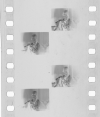 |
Raycolor from 1929. Two quarter sized frames on 35mm. |
 This
is a digital composition from the frames made with Photoshop 7. This
is a digital composition from the frames made with Photoshop 7. |
| 9 |
 |
A stitched join, the film is joined by sewing the two parts together | |
| 10 |
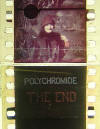 |
Polychromide process. Invented by Aron Hamburger. His 1922 patent GB203358 describes the method of dye-toning. The original negatives were made with a beam-splitter camera. An orthochromatic negative sensitised with erythrosine and a panchromatic negative sensitised with pinacryptol were used. Positive prints were made on duplex stock (emulsion on both sides) the print from the orthochromatic negative was toned with magenta and auramine and on the other side the print from the panchromatic negative was dyed with malachite green and helio safranin. The film was then bleached, cleared, washed and dried. Further details can be found in 'Colour Cinematography' by Cornwell-Clyne pages 339-341 |
|
| 11 |
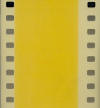 |
This is a piece of pre-tinted raw stock where the area for the sound track has not been tinted so that the yellow tint does not affect the sound volume. I believe that this was called 'sunshine' yellow. Eastman introduced this stock in May 1929 and called it 'Clear Track'. | |
| 12 |
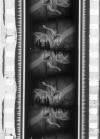 |
This sample is an early version of '2 perf' print. The images are 2 perforations high but alternate images are upside-down. The film was produced to project first one way showing every other frame through a 2 perf mask in the centre of the normal 35mm academy mask. The film was then shown from the other end to project the second set of pictures. The two sound tracks correspond to the two sets of pictures. This all enabled a normal reel of film projected at 24 frames a second to last twice as long. |
|
| 13 |
 |
Francitacolor process. Three frames on 35mm width film. A normal B/W print was projected using a projector with three objectives through red, green and blue filters. The main problem was the usual one with additive systems - lack of picture brightness. A feature was made using this system in France and exhibited in July 1935 in Paris |
 This
is a digital composition from the frames made with Photoshop 7. This
is a digital composition from the frames made with Photoshop 7. |
| 14 |
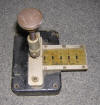 |
Lawley clip inserter. Lawley clips were nickel-silver staples inserted in the perforations. The strips were punched from a roll of nickel silver.(see below) | |
| 15 |
|
A Kodak logo found on some Ektachrome 16mm print film. It appears to be the EKC logo. I believe that it was printed by Kodak when processing Kodachrome film. | |
| 16 |
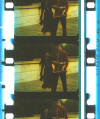 |
Dunning Colour from
The National News issued on
|
|
| 17 |
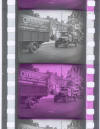 |
This sample and 17a and 17b below come from a London collection. It appears to be someone's experiments with two colour. Digital compositions using Photoshop 7. Note the fringing caused by
time-parallax error. The objects have moved between the two frames |
|
| 17a |
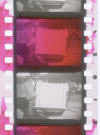 |
See 17 above.
|
|
| 17b |
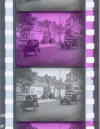 |
 See17
above See17
above |
|
| 18 |
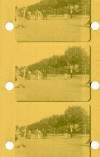 |
35mm with circular perforations | |
| 19 |
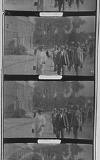 |
17.5mm Film Biocam. These frames come from a comedy film by G A Smith. The format was around from 1899 to approximately the First World War. | |
| 20 |
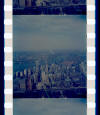
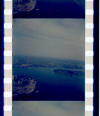 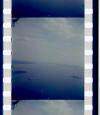 |
Three Cinerama Images | |
| 21 |
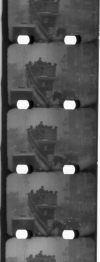 |
17.5mm with two central perforations Duoscope introduced 1912 | |
| 22 |
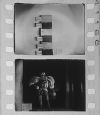
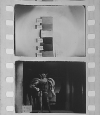
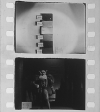 |
Unknown three colour separation tests. The colours are labelled in
French
|
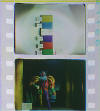 Digital
combination using Photoshop 7 Digital
combination using Photoshop 7 |
| 23 |
 |
I believe this to be two colour Technicolor, you can see traces of the orange/red and green images on the edges of the frames. I have been informed by Nicolay Sharkanov that this frame comes from "Gold diggers of Broadway" (1929) and Winnie Lightner and Albert Gran appear in the frame. | |
| 24 |
 |
Early sound recording. The date code on the film is UK 1927, it is 35mm nitrate film. | |
| 25 |
 |
This is a sample of Dascolor, It was a 2 colour duplex process, emulsion on both sides. One emulsion was toned with Iron Ferricyanide and the other toned with an orange dye. You can see traces of the orange dye in the perforations | |
| 26 |
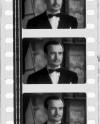 |
35mm Kodak Lenticular Color print. The base had moulded lenses to split the light which was then projected through three colour filters. The same process was used for16mm Kodacolor Lenticular film. | |
| 27 |
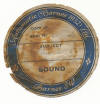 |
This is a can label from Automatic (Barnes 1932) it was from a Dufaycolor sound neg of a film called 'Dawn' | |
| 28 |
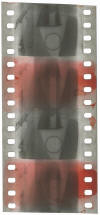 |
This is a piece of B/W Negative that has been coloured red on alternate
frames. I wondered if it was painted before exposure but it
would have been difficult to ensure it was in rack in the camera and could
have washed off in processing. As an experiment I decided to combine the
images using Photoshop, the red image in the red channel and the plain image
in the blue and green channels. The image was inverted and adjusted
for brightness and contrast. This is the result.
There certainly seems to be colour information there. |
|
| 29 |
|
A section of 2 3/8 width film with a piece of 35mm for comparisom. | |
| 30 |
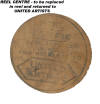 |
A wooden reel centre from United Artists. Note there is no hole through the centre | |
| 31 |
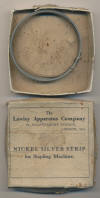 |
A box containing nickel-silver strip for use in a Lawley clip inserter. see page on Cueing for details of Lawley clips. See above for Lawley Clip inserter. | |
| 32 |
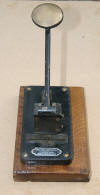
 |
Lawley De-Clipper - device for removing Lawley clips. See above for Lawley Clip inserter. | |
| 33 |
|
The end of a leader on a Technicolor Cyan matrix. The special leader with extra large perfs is attached by brass clips. | |
| 34 |
 |
A label from a can of Eastman Positive Nitrate Motion Picture Film Type 1301.. Note rubber stamp with 'NEG PERFORATIONS', stuck-on label 'For TECHNICOLOR' and that it has dimensions in imperial (1000ft 1 3/8inches) and Metric (304.8 metres and 35mm). | |
| 35 |
 |
A piece of 35mm combined Black and White Positive with 4 small holes at each perforation. Close examination shows that there is a unilateral variable Area track. (see second picture) | |
| 36 |
|
A sample of 16mm from the 1930s. There is a track each side and alternate frames are upside down and also alternate single and double perforations. The film had a note with it saying that the system was designed to run at 4/5 the speed of 35mm rather than the 2/5 of normal 16mm and thus increase the sound quality. | |
| 37 |
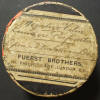 |
An unopened roll of unexposed film supplied by the Fuerst Brothers.
The label says 'Negative Film Lumiere Perforations - Open in Darkroom only' Fuerst Brothers started trading in 1884. They were operating from the address on the can in 1899 and still there in 1915. |
|
| 38 |
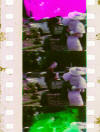
 |
Sample of Brewstercolor. Note that this is a duplex system with
emulsions on both sides of the film. Emulsion has been removed from each
side to show magenta and green images. Invented by P D Brewster the
camera had a rotating mirror to capture the three colours. The
negatives were printed onto duplex stock, the red negative on one side which
was then dye toned cyan and the green image printed onto the other side and
dye toned magenta. The blue image was printed in yellow by imbibition
on top of the red toned image. You can see where the emulsion has been
removed leaving either a magenta or green image (yellow plus cyan).
Close examination of the image shows registration problems due to time
parallax errors and printing difficulties. The first picture was scanned from a frame in the middle of a pan, the frame on the right is much sharper. |
|
| 39 |
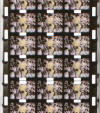
 |
A sample of three row 9.5mm Stencil colour. The frame on the right is an enlargement. Note also the faulty perforation second row from the bottom of the main image. | |
| 40 |
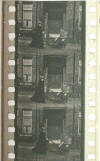
 |
This is a sample of B/W positive from the National Media Museum in Bradford. The note with it is shown with the note typed out below
Print made about Mar 29th 1895 from negative taken in a camera made by R W Paul and operated by Birt Acres at “Clovelly Cottage”, Park Road, Barnet in front of the premises as a test piece 40 ft long and believed to be the first film produced in England for the Kinetoscope. The film was made by G Blair at Foot’s Cray Kent. B.B 7/7/26
|
|
| 41 |
 |
Here is a piece of film with a piece of 16mm for comparison. It appears to be 11/16" wide with 2 perfs per frame. This is a sample from the National Media Museum, Bradford. | |
| 42 |
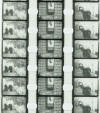 |
Another piece of film from the National Media Museum, Bradford. 1" wide with 3 rows of pictures and two rows of perfs down the middle. | |
| 43 |
|
This is also from the National Media Museum, Bradford and was found in the
Charles Urban collection. There was no information about it. The film
is 1 5/32 inches (about33mm) wide The image alongside is a digital
reconstruction using Photoshop.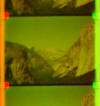 |
|
| 44 |
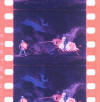 |
Another sample from the Charles Urban collection at the National Media Museum. No details are available but it appears very interesting. It looks like two colour with an iron tone blue layer and a red layer. However the 'Eastman' edge print is white and there are parts of the image that are also white. The fact that the perforations are red makes me think that this layer might be formed by dye destruction. Red toning would not give this effect nor would red tinting. | |

